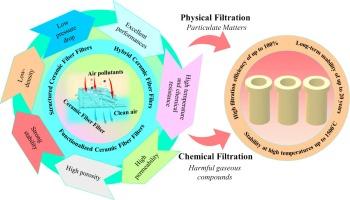先进的陶瓷纤维过滤器:创新和有效的废气处理,以提高空气质量
IF 5.9
3区 工程技术
Q1 CHEMISTRY, MULTIDISCIPLINARY
Journal of Industrial and Engineering Chemistry
Pub Date : 2025-05-05
DOI:10.1016/j.jiec.2025.04.063
引用次数: 0
摘要
空气污染仍然是一个严峻的环境和公共卫生挑战,需要能够有效去除空气污染物的先进过滤技术。陶瓷纤维过滤器(cff)由于其优异的热稳定性,耐化学性和耐用性而成为有前途的解决方案。本文综述了cff用于空气净化的综合分析,重点介绍了它们在去除颗粒物(PM2.5、PM10)、重金属气溶胶、挥发性有机化合物和氮氧化物方面的有效性。随着材料设计和制造的最新进展,纤维结构、孔隙率和涂层影响过滤效率。这篇综述的一个关键创新之处在于它强调整合催化材料来实现同时过滤和污染物降解。先进的催化剂,包括金属氧化物、碳基材料和纳米结构复合材料,在提高过滤效率和延长过滤器寿命方面的作用进行了评估。此外,结合光催化、电催化和吸附的混合过滤策略被探索为解决复杂空气污染物的新兴方法。还讨论了诸如机械稳定性、再生限制和催化剂失活等挑战,并提出了优化过滤器性能的策略。通过总结近年来的研究进展和确定重点研究方向,本文综述了高性能cff的未来发展,为可持续和高效的废气处理提供了宝贵的见解。本文章由计算机程序翻译,如有差异,请以英文原文为准。

Advanced ceramic fiber filters: Innovations and efficacy in exhaust gas treatment for enhanced air quality
Air pollution remains a critical environmental and public health challenge, necessitating advanced filtration technologies capable of efficiently removing airborne pollutants. Ceramic fiber filters (CFFs) have emerged as promising solutions due to their exceptional thermal stability, chemical resistance, and durability. This review provides a comprehensive analysis of CFFs for air purification, with a focus on their effectiveness in removing particulate matter (PM2.5, PM10), heavy metal aerosols, volatile organic compounds, and nitrogen oxides. Fiber structure, porosity, and coatings influence filtration efficiency, with recent advances in material design and fabrication. A key innovation of this review lies in its emphasis on integrating catalytic materials to achieve simultaneous filtration and pollutant degradation. The role of advanced catalysts, including metal oxides, carbon-based materials, and nanostructured composites, is evaluated in enhancing filtration efficiency and extending filter lifespan. Additionally, hybrid filtration strategies incorporating photocatalysis, electrocatalysis, and adsorption are explored as emerging approaches for addressing complex air pollutants. Challenges such as mechanical stability, regeneration limitations, and catalyst deactivation are also discussed, with proposed strategies for optimizing filter performance. By consolidating recent advancements and identifying key research directions, this review offers valuable insights into the future development of high-performance CFFs for sustainable and efficient exhaust gas treatment.
求助全文
通过发布文献求助,成功后即可免费获取论文全文。
去求助
来源期刊
CiteScore
10.40
自引率
6.60%
发文量
639
审稿时长
29 days
期刊介绍:
Journal of Industrial and Engineering Chemistry is published monthly in English by the Korean Society of Industrial and Engineering Chemistry. JIEC brings together multidisciplinary interests in one journal and is to disseminate information on all aspects of research and development in industrial and engineering chemistry. Contributions in the form of research articles, short communications, notes and reviews are considered for publication. The editors welcome original contributions that have not been and are not to be published elsewhere. Instruction to authors and a manuscript submissions form are printed at the end of each issue. Bulk reprints of individual articles can be ordered. This publication is partially supported by Korea Research Foundation and the Korean Federation of Science and Technology Societies.

 求助内容:
求助内容: 应助结果提醒方式:
应助结果提醒方式:


